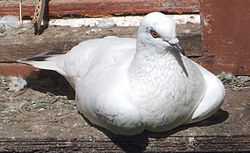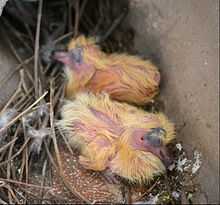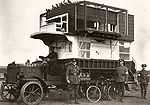Homing pigeon

The homing pigeon is a variety of domestic pigeon (Columba livia domestica) derived from the rock pigeon, selectively bred to find its way home over extremely long distances.[1] The wild rock pigeon has an innate homing ability,[2] meaning that it will generally return to its nest and mate. This made it relatively easy to breed from the birds that repeatedly found their way home over long distances. Flights as long as 1,800 km (1,100 miles) have been recorded by birds in competitive pigeon racing.[3] Their average flying speed over moderate distances is around 80 km/h (50 miles per hour) but speeds of up to 140 km/h (90 miles per hour) have been observed in top racers for short distances. Homing pigeons are called messenger or carrier pigeons when they are used to carry messages. They were used in many places in the world and in wars.
Sexual dimorphism
Male and female pigeons (cocks and hens respectively), can be differentiated by physical characteristics of the head, beak, height, and breast, though visual identification of gender by physical characteristics alone can be inaccurate. Males usually stand taller, and have a larger beaks, crops, wattles,[4] and eye ceres (fleshy growth around the eyes), as well as a round head and thicker nape. Females, on the other hand, tend to be shorter with smaller beaks, wattles, and ceres, as well as flatter heads and fuller breasts.
Male and female pigeons also show different behaviours. The "coo" of males is louder and more insistent, especially when courting. Display behaviour also differs between the sexes. Most notably, males often turn 360 degrees with an inflated crop and a loud "coo", to show interest in a female or to defend or discourage another pigeon from entering its territory (usually a nesting box), while females almost never turn full circle, but rather do a 270 degrees back-and-forth rotational motion.
Although the sexual dimorphism in homing pigeons is rather subtle most accomplished breeders of homing pigeons will easily distinguish the genders of this breed (this is not true for all breeds of domestic pigeon; for instance, archangels have males and females looking almost exactly alike).
Reproduction

During breeding season, usually during the warmer months, a male pigeon will court the female by puffing out his chest, bobbing his head and strutting in circles around her, all the while cooing his affections. If she accepts, she will allow him onto her back in order to copulate. After mating the male will build a nest out of gathered sticks in a suitable crevice, while the female watches and makes changes. Urban birds will gladly use a roof on a building. The female will usually lay two eggs which will hatch in 17 to 20 days. Both parents aid in rearing the nestlings. Fledglings usually leave the nest three to four weeks after hatching.
History

The sport of flying homing pigeons was well-established as early as 3000 years ago.[5] They were used to proclaim the winner of the Olympics.[5][6] Messenger pigeons were used as early as 1150 in Baghdad[7] and also later by Genghis Khan. By 1167 a regular service between Baghdad and Syria had been established by Sultan Nour-Eddin.[8] In Damietta, by the mouth of the Nile, the Spanish traveller Pedro Tafur saw carrier pigeons for the first time, in 1436, though he imagined that the birds made round trips, out and back.[9] The Republic of Genoa equipped their system of watch towers in the Mediterranean Sea with pigeon posts. Tipu Sultan used carrier pigeons. They returned to the Jamia Masjid mosque in Srirangapatna, which was his headquarters. The pigeon holes may be seen in the mosque's minarets to this day.
In 1818, a great pigeon race called the Belgian Concourse took place at Brussels.[5] In 1860, Paul Reuter, who later founded Reuters press agency, used a fleet of over 45 pigeons to deliver news and stock prices between Brussels and Aachen, the terminals of early telegraph lines. The outcome of the Battle of Waterloo was also first delivered by a pigeon to England. During the Franco-Prussian War pigeons were used to carry mail between besieged Paris and the French unoccupied territory. Possibly the first regular air mail service in the world was Mr. Howie's Pigeon-Post service from the Auckland New Zealand suburb of Newton to Great Barrier Island, starting in 1896. Certainly the world’s first 'airmail' stamps were issued for the Great Barrier Pigeon-Gram Service from 1898 to 1908.[10]
Homing pigeons were still employed in the 21st century by certain remote police departments in Odisha state in eastern India to provide emergency communication services following natural disasters. In March 2002, it was announced that India's Police Pigeon Service messenger system in Odisha was to be retired, due to the expanded use of the Internet.[11] The Taliban banned the keeping and/or use of homing pigeons in Afghanistan.[12]
Navigation
Research has been performed with the intention of discovering how pigeons, after being transported, can find their way back from distant places they have never visited before. Most researchers believe that homing ability is based on a "map and compass" model, with the compass feature allowing birds to orient and the map feature allowing birds to determine their location relative to a goal site (home loft).[13] While the compass mechanism appears to rely on the sun, the map mechanism has been highly debated.[14] Some researchers believe that the map mechanism relies on the ability of birds to detect the Earth's magnetic field. It is true that birds can detect a magnetic field, to help them find their way home. Scientists have found that on top of pigeon's beak large number of particles of iron are found which remain aligned to north like man made compass, thus it acts as compass which helps pigeon in determining its home. A light-mediated mechanism that involves the eyes and is lateralized has been examined somewhat, but recent developments have implicated the trigeminal nerve in magnetoception.[15][16] Research by Floriano Papi (Italy, early 1970s) and more recent work, largely by Hans Wallraff, suggests that pigeons also orient themselves using the spatial distribution of atmospheric odors,[14] known as olfactory navigation. Near their home lofts, in areas they have previously visited, pigeons probably are guided by visual landmarks.
Recent research by Jon Hagstrum of the US Geological Survey suggests that homing pigeons use low frequency infrasound to navigate.[17] Sound waves as low 0.1 Hz have been observed to disrupt, or redirect pigeon navigation. The pigeon ear, being far too small to interpret such a long wave, directs pigeons to fly in a circle when first taking air, in order to mentally map such long infrasound waves.
Various experiments suggest that different breeds of homing pigeons rely on different cues to different extents. Charles Walcott at Cornell University was able to demonstrate that while pigeons from one loft were confused by a magnetic anomaly in the Earth it had no effect on birds from another loft 1.6 km (1 mile) away. Other experiments have shown that altering the perceived time of day with artificial lighting or using air conditioning to eliminate odors in the pigeons' home roost affected the pigeons' ability to return home.
Some research also indicates that homing pigeons navigate by following roads and other man-made features, making 90 degree turns and following habitual routes, much the same way that humans navigate.[18]
Roles
As carrier pigeons
When used as carrier pigeons in pigeon post a message is written on thin light paper and rolled into a small tube attached to the bird's leg. Pigeons can only go back to one "mentally marked" point that they have identified as their home. So "pigeon mail" can only work when the sender is actually holding the receiver's pigeons. White homing pigeons are used in release dove ceremonies at weddings, funerals, and some sporting events.
In war
-
 Media related to Pigeons in World War I at Wikimedia Commons
Media related to Pigeons in World War I at Wikimedia Commons

Birds were used extensively during World War I. One homing pigeon, Cher Ami, was awarded the French Croix de guerre for her heroic service in delivering 12 important messages, despite having been very badly injured.

During World War II, the Irish Paddy, the American G.I. Joe and the English Mary of Exeter all received the Dickin Medal. They were among 32 pigeons to receive this award, for their gallantry and bravery in saving human lives with their actions. Eighty-two homing pigeons were dropped into the Netherlands with the First Airborne Division Signals as part of Operation Market Garden in World War II. The pigeons' loft was located in London which would have required them to fly 390 km (240 miles) to deliver their messages.[19] Also in World War II, hundreds of homing pigeons with the Confidential Pigeon Service were airdropped into northwest Europe to serve as intelligence vectors for local resistance agents. Birds played a vital part in the Invasion of Normandy as radios could not be used for fear of vital information being intercepted by the enemy.
In computing
The humorous IP over Avian Carriers (RFC 1149) is an Internet protocol for the transmission of messages via homing pigeon. Originally intended as an April Fools' Day RFC entry, this protocol was implemented and used, once, to transmit a message in Bergen, Norway on April 28, 2001.[20]
In September 2009, a South African IT company based in Durban pitted an 11-month-old bird armed with a data packed 4GB memory stick against the ADSL service from the country's biggest internet service provider, Telkom. The pigeon, Winston, took an hour and eight minutes to carry the data 80 km (50 miles). In all, the data transfer took two hours, six minutes, and fifty-seven seconds—the same amount of time it took to transfer 4% of the data over the ADSL.[21][22]
See also
- List of pigeon breeds
- American Show Racer
- Domestic pigeon
- Dovecote
- Pigeon intelligence
- Pigeon photography
- Tippler
- War pigeon
- Otto J. Zahn, who established a pigeon messenger service from Santa Catalina Island to the mainland of California
References
- ↑ Levi, Wendell (1977 Pg82). The Pigeon. Sumter, S.C.: Levi Publishing Co, Inc. ISBN 0-85390-013-2. Check date values in:
|date=(help) - ↑ Blechman, Andrew (2007). Pigeons-The fascinating saga of the world's most revered and reviled bird. St Lucia, Queensland: University of Queensland Press. ISBN 978-0-7022-3641-9.
- ↑ Walcott, Charles (1996). "Pigeon Homing: Observations, Experiments and Confusions" (Pdf article). Journal of Experimental Biology 199 (Pt 1): 21–7. PMID 9317262. Retrieved 2008-01-04.
- ↑ Darwin, Charles (2008). The Descent of Man, and Selection in Relation to Sex by Charles Darwin. Boston. ISBN 9781605016429.
- ↑ 5.0 5.1 5.2 Teale, Edwin (June 1936). "Mile-a-Minute Pigeons". Popular Science Monthly 128 (6): 25ff.
- ↑ Blechman, Andrew (2007). Pigeons-The fascinating saga of the world's most revered and reviled bird. St Lucia, Queensland: University of Queensland Press. ISBN 978-0-7022-3641-9.
- ↑ First Birds' Inn: About the Sport of Racing Pigeons
- ↑ Allatt, Captain H.T.W. (1886). "The Use of Pigeons as Messengers in War and the Military Pigeon Systems of Europe". Royal United Service Institution (Whitehall, London: W. Mitchell & Co.) 30 (133): 107–148 [111]. doi:10.1080/03071848609416366. Retrieved 24 November 2012.
- ↑ "I saw there for the first time carrier pigeons, which take letters in their tail-feathers. They carry them from the place where they are bred to other places, and when the letters are detached they are set free and return to their homes. By this means the inhabitants have speedy news of all who come and go by sea or land." (Pedro Tafur, Andanças e viajes).
- ↑ The Great Barrier Island Pigeon-Gram Service
- ↑ "Indian pigeons lose out to e-mail". BBC News. 2002-03-26. Retrieved 2010-03-27.
- ↑ "Some of the restrictions imposed by Taliban on women in Afghanistan" (Web article). Revolutionary Association of the Women of Afghanistan (RAWA). Retrieved 2008-01-03.
- ↑ Bingman, V. P. (1998). Spatial representations and homing pigeon navigation. In S. Healy (Ed). Spatial representation in animals. (pp. 67-85). Oxford: Oxford University Press.
- ↑ 14.0 14.1 Wallraff, H.G. (2004). Avian olfactory navigation: its empirical foundation and conceptual state. Animal Behaviour, 67, 189-204.
- ↑ Mora, C. V., Davison, M., Wild, J. M., and Walker, M. M. (2004). Magnetoreception and its trigeminal mediation in the homing pigeon. Nature, 432, 508-511.
- ↑ Gagliardo, A., Ioale, P., Savini, M., and Wild, J. M. (2006). Having the nerve to home: trigeminal magnetoreceptor versus olfactory mediation of homing in pigeons. The Journal of Experimental Biology, 209, 2888-2892.
- ↑ Knight, Kathryn (2013). Disappearing homing pigeon mystery solved. The Company of Biologists. Retrieved 2013-01-31
- ↑ "Pigeons reveal map reading secret". BBC News (5 Feb, 2004). 2004-02-05. Retrieved 2008-07-02.
- ↑ Cornelius Ryan - A Bridge Too Far
- ↑ Bergen Linux User Group - The highly unofficial CPIP WG
- ↑ Govender, Peroshni (2009-09-09). "Pigeon transfers data faster than South Africa's Telkom". Reuters (September 9, 2009). Retrieved 2009-10-09.
- ↑ "SA pigeon 'faster than broadband'". BBC (September 10, 2009). 2009-09-10. Retrieved 2009-10-09.
Further reading
- Chico, the Story of a Homing Pigeon in the Great War, Lucy M Blanchard, Diggory Press, ISBN 978-1-84685-039-4
- Wringer by Jerry Spinelli
- A Pigeon and a Boy, by Meir Shalev (English translation by Evan Fallenberg), a historical novel about the use of pigeons by the Israel Defense Forces (and the Haganah before Israel was founded in 1948) in the defence of Israel when it was first founded, and in the defence of the Jewish community before Israeli independence
- Tegetmeier, William Bernhard (1871). The homing or carrier pigeon. London: George Routledge.
- "Nine Champions Create A Champion", Bob Kinney Silverado, The Thoroughbred, 15 May 1998
External links
| Wikimedia Commons has media related to Homing pigeons. |
- An informative magazine article written in the 1880s
- Pigeon and Business and Communication
- The three most important things that every pigeon fancier should know
- The great pigeon race disaster of 97 suggests an answer to an enduring mystery, George Johnson, "ON SCIENCE", St. Louis Post Dispatch
- The System of Military Dovecotes in Europe from an 1891 Scientific American article at Project Gutenberg
- RFC 1149 - A Standard for the Transmission of IP Datagrams on Avian Carriers
- Beginning pigeon site
- Resource for pigeon racers
- Round Trip War Birds, Popular Science, November 1941, article on US Army Signal Corps use of homing pigeons with first high-speed photos showing how a pigeon flies
- Barnhart & Son Lofts, long-time breeder, exhibitor, and judge of fancy and racing pigeons
- Fragment 'Those waiting for the birds' (2008, Eve Duchemin), documentary about Belgian homing pigeons